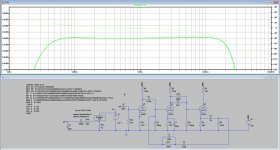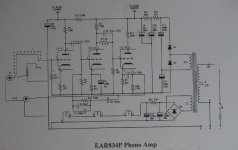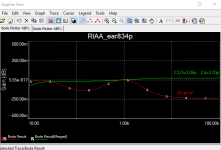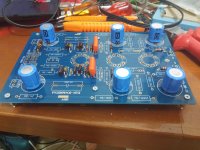hi
my new project is to build the EAR834 phono stage.
i order Quality components for the riaa but the values are Inaccurate, how it is Affect on the FR?
my valuse are 130p (110p-Theory)
850k(750k-Theory)
335p(330p-Theory)
thanks
my new project is to build the EAR834 phono stage.
i order Quality components for the riaa but the values are Inaccurate, how it is Affect on the FR?
my valuse are 130p (110p-Theory)
850k(750k-Theory)
335p(330p-Theory)
thanks
Attachments
Last edited:
Wrong values will give the wrong response, but this might not be as bad as you might fear. Most important is to ensure that both channels have the same error.
Many RIAA networks are wrong anyway, as not all designers know how to do the calculations and some even imagine they can skip thinking and 'tune by ear' instead.
Many RIAA networks are wrong anyway, as not all designers know how to do the calculations and some even imagine they can skip thinking and 'tune by ear' instead.
Wrong values will give the wrong response, but this might not be as bad as you might fear. Most important is to ensure that both channels have the same error.
Many RIAA networks are wrong anyway, as not all designers know how to do the calculations and some even imagine they can skip thinking and 'tune by ear' instead.
To all the audio fans reading and participating in this great forum, keep up the good work, I 've been reading and participating for many years now. But I can't recall a single word being written about the listener's ear response and its compliance with the RIAA or the FletcherMunson curve or whatever. I know a listener who enjoys music, live or recorded but can't carry on a conversation without a hearing aid blasting in the deaf ears. Breaking glass is heard, human voices, not well at all. Great holes in the ear's response curve. I suspect that the average, pretty good ear is pitifully far from the accuracy we seem to be demanding of our networks.
BillG
Whose own ears are down some 20 or more DB from where they should be at 6 to 8 Khz.
Need to get closer on the 750K resistor, I would use a couple of resistors in series to get as close as reasonably possible. The 130pF is a bit high too, try to get a bit closer. 335pF is OK. Matching between the channels is very important, but so is some level of conformance with the RIAA curve, the errors occur over the entire frequency range and may not be subtle if you are several dB down at 20Hz or 20kHz, or the turn over points are in the wrong spots.
10% component error means you could be up to 0.8dB out on frequency response. This is probably well within the errors in speakers, rooms, and cartridges (and tonearms?). However, to be on the safe side try to get closer than this, and even better channel matching.
So if you calculated 330pF and used 335pF that is fine. You could even use 350pF and just get a little HF rolloff. What you should not do is use 335pF in one channel and 350pF in the other channel.
So if you calculated 330pF and used 335pF that is fine. You could even use 350pF and just get a little HF rolloff. What you should not do is use 335pF in one channel and 350pF in the other channel.
10% component error means you could be up to 0.8dB out on frequency response. This is probably well within the errors in speakers, rooms, and cartridges (and tonearms?). However, to be on the safe side try to get closer than this, and even better channel matching.
So if you calculated 330pF and used 335pF that is fine. You could even use 350pF and just get a little HF rolloff. What you should not do is use 335pF in one channel and 350pF in the other channel.
thanks 🙂
The designers omitted the resistor in parallel with C4,Let's call it R15
http://www.diyaudio.com/forums/blogs/hbc/1077-heretical-834p-mods.html
R12 * (C2||C3) should equal 75uS (T5)
R15* C4 should equal 3180uS (T3)
R12/R15 ~= 11.8 or 8.8Meg
The approximate value of C4 should be ~360p
C2 is ...
http://www.diyaudio.com/forums/blogs/hbc/1077-heretical-834p-mods.html
R12 * (C2||C3) should equal 75uS (T5)
R15* C4 should equal 3180uS (T3)
R12/R15 ~= 11.8 or 8.8Meg
The approximate value of C4 should be ~360p
C2 is ...
The designers omitted the resistor in parallel with C4,Let's call it R15
http://www.diyaudio.com/forums/blogs/hbc/1077-heretical-834p-mods.html
R12 * (C2||C3) should equal 75uS (T5)
R15* C4 should equal 3180uS (T3)
R12/R15 ~= 11.8 or 8.8Meg
The approximate value of C4 should be ~360p
C2 is ...
thanks for the link
Definitely try your changes
Eric Margan wrote an article on tuning the RIAA network. You might find it useful.
http://www-f9.ijs.si/~margan/Audio/Ironing_RIAA.pdf
http://www-f9.ijs.si/~margan/Audio/Ironing_RIAA.pdf
thanks all
i send the seller (electricslee from ebay) message and he send me the exactly value for free 🙂
i send the seller (electricslee from ebay) message and he send me the exactly value for free 🙂
The designers omitted the resistor in parallel with C4, Let's call it R15
So, finally back to the simulator. R15 is not necessary, the 3180 uS compensation is accomplished otherwise. With the original values the RIAA compliance seems to be quite good (better than +/- 0.125dB). With a couple tweaks it is theoretically close to perfect.
But it's just simulation.
For the record, I centered the response around 1kHz = 0.0dB
Attachments
> 3180 uS compensation is accomplished otherwise.
Limited gain in V2.
This means the sub-50Hz response depends on tube parameters instead of R and C. This is mildly compensated by the NFB/EQ loop terminating into V1 plate; at least to first-order, B+ variations cancel.
Limited gain in V2.
This means the sub-50Hz response depends on tube parameters instead of R and C. This is mildly compensated by the NFB/EQ loop terminating into V1 plate; at least to first-order, B+ variations cancel.
That article should be treated with caution. He gets his algebra wrong (eq (18) is not in the same form as eq (1)) so he gets wrong component values which he then has to patch up. The wrong frequency response in fig 6 and 7 should have warned him to check for errors.rayfutrell said:Eric Margan wrote an article on tuning the RIAA network. You might find it useful.
http://www-f9.ijs.si/~margan/Audio/Ironing_RIAA.pdf
He then goes on aim for electrically flat frequency response including the cartridge inductance etc. (ignoring the mechanical frequency response) so he wrongly concludes that the input capacitance should be low. Some cartridges require a high capacitance load so the electrical peak compensates for a mechanical HF droop.
Following his advice more or less guarantees a poor RIAA response.
Off topic but thanks for the warning. I knew his formula for the cartridge Q was wrong but was unaware his other algebra also had mistakes.
Using the 12AX7 I got the frequency response below including a Cart connected.

The cart was assumed to have 300mH and 600Ohm (L1, R14)
Cable capacity connecting TT and EAR834 was set at 60pF (C8)
An input cap C5=200nF was added to flatten the LF response and act as rumble filter.
C3 was lowered from 110pF to 105pF and C4 was lowered from 330pF to 320pF.

The cart was assumed to have 300mH and 600Ohm (L1, R14)
Cable capacity connecting TT and EAR834 was set at 60pF (C8)
An input cap C5=200nF was added to flatten the LF response and act as rumble filter.
C3 was lowered from 110pF to 105pF and C4 was lowered from 330pF to 320pF.
Flat electrical response will not necessarily mean flat total response. Depends on the cartridge, and what capacitive load it needs.
Flat electrical response will not necessarily mean flat total response. Depends on the cartridge, and what capacitive load it needs.
That's why, when designing an MM amp, one has to assume some average which is 300mH and 600 Ohm for the cart, 60pf for the cable and a very low mass for the tip with supersonic mechanical resonance.
This can be regarded being the best possible starting point and that is as far as you can go with a general design.
Further tweaking with extra input caps to get the HF response above 10Khz as flat as possible is up to the user .
Below 10Khz the projected frequency response will hardly be influenced by different cartridges, unless they are extremely different.
So your point is correct but a bit pointless.
Hans
Newbies seeing your post 17 might not have realised what you then explained in post 19. Even so-called 'experts' can get this wrong (see my post 14).
That was the point of my post.
That was the point of my post.
- Status
- Not open for further replies.
- Home
- Source & Line
- Analogue Source
- RIAA filter not accurate



